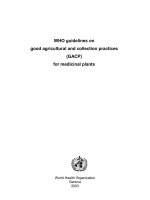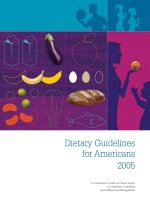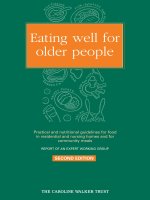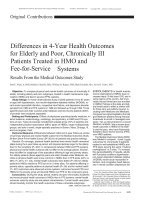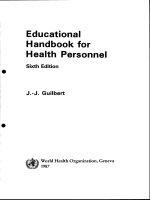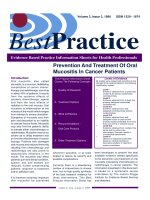Nutritional Counseling for Lifestyle Change ppt
Bạn đang xem bản rút gọn của tài liệu. Xem và tải ngay bản đầy đủ của tài liệu tại đây (23 MB, 2,167 trang )
~C00KIEEE~
ENCYCLOPEDIA OF
HUMAN
NUTRITION
SECOND EDITION
ENCYCLOPEDIA OF
HUMAN
NUTRITION
SECOND EDITION
Editor-in-Chief
BENJAMIN CABALLERO
Editors
LINDSAY ALLEN
ANDREW PRENTICE
ACADEMIC
PRESS
Amsterdam Boston Heidelberg London New York Oxford
Paris San Diego San Francisco Singapore Sydney Tokyo
Elsevier Ltd., The Boulevard, Langford Lane, Kidlington, Oxford, OX5 1GB, UK
ª 2005 Elsevier Ltd.
The following articles are US Government works in the
public domain and not subject to copyright:
CAROTENOIDS/Chemistry, Sources and Physiology
FOOD FORTIFICATION/Developed Countries
FRUCTOSE
LEGUMES
TEA
TUBERCULOSIS/Nutrition and Susceptibility
TUBERCULOSIS/Nutritional Management
VEGETARIAN DIETS
All rights reserved. No part of this publication may be reproduced or transmitted in any form or by any
means, electronic, or mechanical, including photocopy, recording, or any information storage and
retrieval system, without permission in writing from the publishers.
Permissions may be sought directly from Elsevier’s Rights Department in Oxford, UK:
phone (+44) 1865 843830, fax (+44) 1865 853333, e-mail
Requests may also be completed on-line via the homepage ( />Second edition 2005
Library of Congress Control Number: 2004113614
A catalogue record for this book is available from the British Library
ISBN 0-12-150110-8 (set)
This book is printed on acid-free paper
Printed and bound in Spain
EDITORIAL ADVISORY BOARD
EDITOR-IN-CHIEF
Benjamin Caballero
Johns Hopkins University
Maryland
USA
EDITORS
Lindsay Allen
University of California
Davis, CA, USA
Andrew Prentice
London School of Hygiene & Tropical Medicine
London, UK
Christopher Bates
MRC Human Nutrition Research
Cambridge, UK
Carolyn D Berdanier
University of Georgia
Athens, GA, USA
Bruce R Bistrian
Harvard Medical School
Boston, MA, USA
Johanna T Dwyer
Frances Stern Nutrition Center
Boston, MA, USA
Paul Finglas
Institute of Food Research
Norwich, UK
Terrence Forrester
Tropical Medicine Research Institute
University of the West Indies,
Mona Campus, Kingston, Jamaica
Hedley C Freake
University of Connecticut
Storrs, CT, USA
Catherine Geissler
King’s College London
London, UK
Susan A Jebb
MRC Human Nutrition Research
Cambridge, UK
Rachel Johnson
University of Vermont
Burlington, VT, USA
Janet C King
Children’s Hospital Oakland Research Institute
Oakland, CA, USA
Anura Kurpad
St John’s National Academy of Health Sciences
Bangalore, India
Kim Fleisher Michaelson
The Royal Veterinary and Agricultural University
Frederiksberg, Denmark
Carlos Monteiro
University of Sa
ˆ
o Paulo
Sa
ˆ
o Paulo, Brazil
John M Pettifor
University of the Witwatersrand & Chris
Hani-Baragwanath Hospital
Johannesburg, South Africa
Barry M Popkin
University of North Carolina
Chapel Hill, NC, USA
Michele J Sadler
MJSR Associates
Ashford, UK
Ricardo Uauy
London School of Hygiene and Tropical Medicine
UK and INTA University of Chile, Santiago, Chile
David York
Pennington Biomedical Research Center
Baton Rouge, LA, USA
vi EDITORIAL ADVISORY BOARD
FOREWORD
W
hy an encyclopedia? The original Greek word means ‘the circle of arts and sciences essential for a
liberal education’, and such a book was intended to embrace all knowledge. That was the aim of the
famous Encyclopedie produced by Diderot and d’Alembert in the middle of the 18th century, which
contributed so much to what has been called the Enlightenment. It is recorded that after all the authors
had corrected the proofs of their contributions, the printer secretly cut out whatever he thought might give
offence to the king, mutilated most of the best articles and burnt the manuscripts! Later, and less controver-
sially, the word ‘encyclopedia’ came to be used for an exhaustive repertory of information on some particular
department of knowledge. It is in this class that the present work falls.
In recent years the scope of Human Nutrition as a scientific discipline has expanded enormously. I used to
think of it as an applied subject, relying on the basic sciences of physiology and biochemistry in much the
same way that engineering relies on physics. That traditional relationship remains and is fundamental, but the
field is now much wider. At one end of the spectrum epidemiological studies and the techniques on which
they depend have played a major part in establishing the relationships between diet, nutritional status and
health, and there is greater recognition of the importance of social factors. At the other end of the spectrum
we are becoming increasingly aware of the genetic determinants of ways in which the body handles food and
is able to resist adverse influences of the environment. Nutritionists are thus beginning to explore the
mechanisms by which nutrients influence the expression of genes in the knowledge that nutrients are
among the most powerful of all influences on gene expression. This has brought nutrition to the centre of
the new ‘post-genome’ challenge of understanding the effects on human health of gene-environment interactions.
In parallel with this widening of the subject there has been an increase in opportunities for training and
research in nutrition, with new departments and new courses being developed in universities, medical schools
and schools of public health, along with a greater involvement of schoolchildren and their teachers. Public
interest in nutrition is intense and needs to be guided by sound science. Governments are realizing more and
more the role that nutrition plays in the prevention of disease and the maintenance of good health, and the
need to develop a nutrition policy that is integrated with policies for food production.
The first edition of the Encyclopaedia of Human Nutrition established it as one of the major reference
works in our discipline. The second edition has been completely revised to take account of new knowledge in
our rapidly advancing field. This new edition is as comprehensive as the present state of knowledge allows,
but is not overly technical and is well supplied with suggestions for further reading. All the articles have been
carefully reviewed and although some of the subjects are controversial and sensitive, the publishers have not
exerted the kind of political censorship that so infuriated Diderot.
J.C. Waterlow
Emeritus Professor of Human Nutrition
London School of Hygiene and Tropical Medicine
February 2005
INTRODUCTION
T
he science of human nutrition and its applications to health promotion continue to gain momentum. In
the relatively short time since the release of the first edition of this Encyclopedia, a few landmark
discoveries have had a dramatic multiplying effect over nutrition science: the mapping of the human genome,
the links between molecular bioenergetics and lifespan, the influence of nutrients on viral mutation, to name
a few.
But perhaps the strongest evidence of the importance of nutrition for human health comes from the fact
that almost 60% of the diseases that kill humans are related to diet and lifestyle (including smoking and
physical activity). These are all modifiable risk factors. As individuals and organizations intensify their efforts
to reduce disease risks, the need for multidisciplinary work becomes more apparent. Today, an effective
research or program team is likely to include several professionals from fields other than nutrition. For both
nutrition and non-nutrition scientists, keeping up to date on the concepts and interrelationships between
nutrient needs, dietary intake and health outcomes is essential. The new edition of the Encyclopedia of
Human Nutrition hopes to address these needs. While rigorously scientific and up to date, EHN provides
concise and easily understandable summaries on a wide variety of topics. The nutrition scientist will find that
the Encyclopedia is an effective tool to ‘‘fill the void’’ of information in areas beyond his/her field of
expertise. Professionals from other fields will appreciate the ease of alphabetical listing of topics, and the
presentation of information in a rigorous but concise way, with generous aid from graphs and diagrams.
For a work that involved more than 340 authors requires, coordination and attention to detail is critical.
The editors were fortunate to have the support of an excellent team from Elsevier’s Major Reference Works
division. Sara Gorman and Paula O’Connell initiated the project, and Tracey Mills and Samuel Coleman saw
it to its successful completion.
We trust that this Encyclopedia will be a useful addition to the knowledge base of professionals involved in
research, patient care, and health promotion around the globe.
Benjamin Caballero, Lindsay Allen and Andrew Prentice
Editors
April 2005
GUIDE TO USE OF THE ENCYCLOPEDIA
Structure of the Encyclopedia
The material in the Encyclopedia is arranged as a series of entries in alphabetical order. Most entries consist of several
articles that deal with various aspects of a topic and are arranged in a logical sequence within an entry. Some entries
comprise a single article.
To help you realize the full potential of the material in the Encyclopedia we have provided three features to help you
find the topic of your choice: a Contents List, Cross-References and an Index.
1. Contents List
Your first point of reference will probably be the contents list. The complete contents lists, which appears at the front of
each volume will provide you with both the volume number and the page number of the entry. On the opening page of an
entry a contents list is provided so that the full details of the articles within the entry are immediately available.
Alternatively you may choose to browse through a volume using the alphabetical order of the entries as your guide. To
assist you in identifying your location within the Encyclopedia a running headline indicates the current entry and the
current article within that entry.
You will find ‘dummy entries’ where obvious synonyms exist for entries or where we have grouped together related
topics. Dummy entries appear in both the contents lists and the body of the text.
Example
If you were attempting to locate material on food intake measurement via the contents list:
FOOD INTAKE see DIETARY INTAKE MEASUREMENT: Methodology; Validation. DIETARY SURVEYS. MEAL SIZE
AND FREQUENCY
The dummy entry directs you to the Methodology article, in The Dietary Intake Measurement entry. At the appropriate
location in the contents list, the page numbers for articles under Dietary Intake Measurement are given.
If you were trying to locate the material by browsing through the text and you looked up Food intake then the following
information would be provided in the dummy entry:
Food Intake see Dietary Intake Measurement:Methodology;Validation.Dietary Surveys. Meal Size and Frequency
Alternatively, if you were looking up Dietary Intake Measurement the following information would be provided:
DIETARY INTAKE MEASUREMENT
Contents
Methodology
Validation
2. Cross-References
All of the articles in the Encyclopedia have been extensively cross-referenced.
The cross-references, which appear at the end of an article, serve three different functions. For example, at the end of
the ADOLESCENTS/Nutritional Problems article, cross-references are used:
i. To indicate if a topic is discussed in greater detail elsewhere.
See also: Adolescents: Nutritional Requirements of Adolescents.
Anemia: Iron-Deficiency Anemia. Calcium: Physiology. Eating Dis-
orders: Anorexia Nervosa; Bulimia Nervosa; Binge Eating. Folic Acid:
Physiology, Dietary Sources, and Requirements. Iron: Physiology, Dietary
Sources, and Requirements. Obesity: Definition, Aetiology, and
Assessment. Osteoporosis: Nutritional Factors. Zinc: Physiology.
ii. To draw the reader’s attention to parallel discussions in other articles.
See also: Adolescents: Nutritional Requirements of Adolescents.
Anemia: Iron-Deficiency Anemia. Calcium: Physiology. Eating Dis-
orders: Anorexia Nervosa; Bulimia Nervosa; Binge Eating. Folic Acid:
Physiology, Dietary Sources, and Requirements. Iron: Physiology, Dietary
Sources, and Requirements. Obesity: Definition, Aetiology, and
Assessment. Osteoporosis: Nutritional Factors Zinc: Physiology.
iii. To indicate material that broadens the discussion.
See also: Adolescents: Nutritional Requirements of Adolescents.
Anemia: Iron-Deficiency Anemia. Calcium: Physiology. Eating Dis-
orders: Anorexia Nervosa; Bulimia Nervosa; Binge Eating. Follic Acid:
Physiology, Dietary Sources, and Requirements. Iron: Physiology, Dietary
Sources, and Requirements. Obesity: Definition, Aetiology, and
Assessment. Osteoporosis: Nutritional Factors. Zinc: Physiology.
3. Index
The index will provide you with the page number where the material is located, and the index entries differentiate
between material that is a whole article, is part of an article or is data presented in a figure or table. Detailed notes are
provided on the opening page of the index.
4. Contributors
A full list of contributors appears at the beginning of each volume.
xii GUIDE TO USE OF THE ENCYCLOPEDIA
CONTRIBUTORS
E Abalos
Centro Rosarino de Estudios Perinatales
Rosario, Argentina
A Abi-Hanna
Johns Hopkins School of Medicine
Baltimore, MD, USA
L S Adair
University of North Carolina
Chapel Hill, NC, USA
A Ahmed
Obetech Obesity Research Center
Richmond, VA, USA
B Ahre
´
n
Lund University
Lund, Sweden
J Akre
´
World Health Organization, Geneva, Switzerland
A J Alberg
Johns Hopkins Bloomberg School of Public Health
Baltimore, MD, USA
L H Allen
University of California at Davis
Davis, CA, USA
D Anderson
University of Bradford
Bradford, UK
J J B Anderson
University of North Carolina
Chapel Hill, NC, USA
R A Anderson
US Department of Agriculture
Beltsville, MD, USA
L J Appel
Johns Hopkins University
Baltimore, MD, USA
A Arin
˜
o
University of Zaragoza
Zaragoza, Spain
M J Arnaud
Nestle S.A.
Vevey, Switzerland
E W Askew
University of Utah
Salt Lake City, UT, USA
R L Atkinson
Obetech Obesity Research Center
Richmond, VA, USA
S A Atkinson
McMaster University
Hamilton, ON, Canada
L S A Augustin
University of Toronto
Toronto, ON, Canada
D J Baer
US Department of Agriculture
Beltsville, MD, USA
A Baqui
Johns Hopkins Bloomberg School of Public Health
Baltimore, MD, USA
Y Barnett
Nottingham Trent University
Nottingham, UK
G E Bartley
Agricultural Research Service
Albany, CA, USA
C J Bates
MRC Human Nutrition Research
Cambridge, UK
J A Beltra
´
n
University of Zaragoza
Zaragoza, Spain
A E Bender
Leatherhead, UK
D A Bender
University College London
London, UK
I F F Benzie
The Hong Kong Polytechnic University
Hong Kong SAR, China
C D Berdanier
University of Georgia
Athens, GA, USA
R Bhatia
United Nations World Food Programme
Rome, Italy
Z A Bhutta
The Aga Khan University
Karachi, Pakistan
J E Bines
University of Melbourne
Melbourne, VIC, Australia
J Binkley
Vanderbilt Center for Human Nutrition
Nashville, TN, USA
R Black
Johns Hopkins Bloomberg School of Public Health
Baltimore, MD, USA
J E Blundell
University of Leeds
Leeds, UK
A T Borchers
University of California at Davis
Davis, CA, USA
C Boreham
University of Ulster at Jordanstown
Jordanstown, UK
F Branca
Istituto Nazionale di Ricerca per gli Alimenti e la Nutrizione
Rome, Italy
J Brand-Miller
University of Sydney
Sydney, NSW, Australia
A Briend
Institut de Recherche pour le De
´
veloppement
Paris, France
P Browne
St James’s Hospital
Dublin, Ireland
I A Brownlee
University of Newcastle
Newcastle-upon-Tyne, UK
H Brunner
Centre Hospitalier Universitaire Vaudois
Lausanne, Switzerland
A J Buckley
University of Cambridge
Cambridge, UK
H H Butchko
Exponent, Inc.
Wood Dale, IL, USA
J Buttriss
British Nutrition Foundation
London, UK
B Caballero
Johns Hopkins Bloomberg School of Public Health and
Johns Hopkins University
Baltimore, MD, USA
E A Carrey
Institute of Child Health
London, UK
A Cassidy
School of Medicine
University of East Anglia
Norwich, UK
G E Caughey
Royal Adelaide Hospital
Adelaide, SA, Australia
xiv CONTRIBUTORS
J P Cegielski
Centers for Disease Control and Prevention
Atlanta, GA, USA
C M Champagne
Pennington Biomedical Research Center
Baton Rouge, LA, USA
S C Chen
US Department of Agriculture
Beltsville, MD, USA
L Cheskin
Johns Hopkins University
Baltimore, MD, USA
S Chung
Columbia University
New York, NY, USA
L G Cleland
Royal Adelaide Hospital
Adelaide, SA, Australia
L Cobiac
CSIRO Health Sciences and Nutrition
Adelaide, SA, Australia
G A Colditz
Harvard Medical School
Boston, MA, USA
T J Cole
Institute of Child Health
London, UK
L A Coleman
Marshfield Clinic Research Foundation
Marshfield, WI, USA
S Collier
Children’s Hospital, Boston, Harvard Medical School,
and Harvard School of Public Health
Boston, MA, USA
M Collins
Muckamore Abbey Hospital
Antrim, UK
K G Conner
Johns Hopkins Hospital
Baltimore, MD, USA
K C Costas
Children’s Hospital Boston
Boston, MA, USA
R C Cottrell
The Sugar Bureau
London, UK
W A Coward
MRC Human Nutrition Research
Cambridge, UK
J M Cox
Johns Hopkins Hospital
Baltimore, MD, USA
S Cox
London School of Hygiene and Tropical Medicine
London, UK
P D’Acapito
Istituto Nazionale di Ricerca per gli Alimenti e la Nutrizione
Rome, Italy
S Daniell
Vanderbilt Center for Human Nutrition
Nashville, TN, USA
O Dary
The MOST Project
Arlington, VA, USA
T J David
University of Manchester
Manchester, UK
C P G M de Groot
Wageningen University
Wageningen, The Netherlands
M de Onis
World Health Organization
Geneva, Switzerland
M C de Souza
Universidad de Mogi das Cruzes
Sa
˜
o Paulo, Brazil
R de Souza
University of Toronto
Toronto, ON, Canada
C H C Dejong
University Hospital Maastricht
Maastricht, The Netherlands
L Demeshlaira
Emory University
Atlanta, GA, USA
CONTRIBUTORS xv
K G Dewey
University of California at Davis
Davis, CA, USA
H L Dewraj
The Aga Khan University
Karachi, Pakistan
C Doherty
MRC Keneba
The Gambia
C M Donangelo
Universidade Federal do Rio de Janeiro
Rio de Janeiro, Brazil
A Dornhorst
Imperial College at Hammersmith Hospital
London, UK
E Dowler
University of Warwick
Coventry, UK
J Dowsett
St Vincent’s University Hospital
Dublin, Ireland
A K Draper
University of Westminster
London, UK
M L Dreyfuss
Johns Hopkins Bloomberg School of Public Health
Baltimore, MD, USA
R D’Souza
Queen Mary’s, University of London
London, UK
C Duggan
Harvard Medical School
Boston, MA, USA
A G Dulloo
University of Fribourg
Fribourg, Switzerland
E B Duly
Ulster Hospital
Belfast, UK
J L Dupont
Florida State University
Tallahassee, FL, USA
J Dwyer
Tufts University
Boston, MA, USA
J Eaton–Evans
University of Ulster
Coleraine, UK
C A Edwards
University of Glasgow
Glasgow, UK
M Elia
University of Southampton
Southampton, UK
P W Emery
King’s College London
London, UK
J L Ensunsa
University of California at Davis
Davis, CA, USA
C Feillet-Coudray
National Institute for Agricultural Research
Clermont-Ferrand, France
J D Fernstrom
University of Pittsburgh
Pittsburgh, PA, USA
M H Fernstrom
University of Pittsburgh
Pittsburgh, PA, USA
F Fidanza
University of Rome Tor Vergata
Rome, Italy
P Fieldhouse
The University of Manitoba
Winnipeg, MB, Canada
N Finer
Luton and Dunstable Hospital NHS Trust
Luton, UK
J Fiore
University of Westminster
London, UK
xvi CONTRIBUTORS
H C Freake
University of Connecticut
Storrs, CT, USA
J Freitas
Tufts University
Boston, MA, USA
R E Frisch
Harvard Center for Population and Development Studies
Cambridge, MA, USA
G Frost
Imperial College at Hammersmith Hospital
London, UK
G Fru
¨
hbeck
Universidad de Navarra
Pamplona, Spain
D Gallagher
Columbia University
New York, NY, USA
L Galland
Applied Nutrition Inc.
New York, NY, USA
C Geissler
King’s College London
London, UK
M E Gershwin
University of California at Davis
Davis, CA, USA
H Ghattas
London School of Hygiene and Tropical Medicine
London, UK
E L Gibson
University College London
London, UK
T P Gill
University of Sydney
Sydney, NSW, Australia
W Gilmore
University of Ulster
Coleraine, UK
G R Goldberg
MRC Human Nutrition Research
Cambridge, UK
JGo
´
mez-Ambrosi
Universidad de Navarra
Pamplona, Spain
J M Graham
University of California at Davis
Davis, CA, USA
J Gray
Guildford, UK
J P Greaves
London, UK
M W Green
Aston University
Birmingham, UK
R Green
University of California
Davis, CA, USA
R F Grimble
University of Southampton
Southampton, UK
M Grønbæk
National Institute of Public Health
Copenhagen, Denmark
J D Groopman
Johns Hopkins University
Baltimore MD, USA
S M Grundy
University of Texas Southwestern Medical Center
Dallas, TX, USA
M A Grusak
Baylor College of Medicine
Houston, TX, USA
M Gueimonde
University of Turku
Turku, Finland
C S Gulotta
Johns Hopkins University and Kennedy
Krieger Institute
Baltimore, MD, USA
P Haggarty
Rowett Research Institute
Aberdeen, UK
CONTRIBUTORS xvii
J C G Halford
University of Liverpool
Liverpool, UK
C H Halsted
University of California at Davis
Davis, CA, USA
J Hampsey
Johns Hopkins School of Medicine
Baltimore, MD, USA
E D Harris
Texas A&M University
College Station, TX, USA
Z L Harris
Johns Hopkins Hospital and School of Medicine
Baltimore, MD, USA
P J Havel
University of California at Davis
Davis, CA, USA
W W Hay Jr
University of Colorado Health Sciences Center
Aurora, CO, USA
R G Heine
University of Melbourne
Melbourne, VIC, Australia
R Heinzen
Johns Hopkins Bloomberg School of Public Health
Baltimore, MD, USA
A Herrera
University of Zaragoza
Zaragoza, Spain
B S Hetzel
Women’s and Children’s Hospital
North Adelaide, SA, Australia
A J Hill
University of Leeds
Leeds, UK
S A Hill
Southampton General Hospital
Southampton, UK
G A Hitman
Queen Mary’s, University of London
London, UK
J M Hodgson
University of Western Australia
Perth, WA, Australia
M F Holick
Boston University Medical Center
Boston, MA, USA
C Hotz
National Institute of Public Health
Morelos, Mexico
R Houston
Emory University
Atlanta, GA, USA
H-Y Huang
Johns Hopkins University
Baltimore, MD, USA
J R Hunt
USDA-ARS Grand Forks Human Nutrition Research Center
Grand Forks, ND, USA
R Hunter
King’s College London
London, UK
P Hyland
Nottingham Trent University
Nottingham, UK
B K Ishida
Agricultural Research Service
Albany, CA, USA
J Jacquet
University of Geneva
Geneva, Switzerland
M J James
Royal Adelaide Hospital
Adelaide, SA, Australia
W P T James
International Association for the Study of Obesity/
International Obesity Task Force Offices
London, UK
A G Jardine
University of Glasgow
Glasgow, UK
S A Jebb
MRC Human Nutrition Research
Cambridge, UK
xviii CONTRIBUTORS
K N Jeejeebhoy
University of Toronto
Toronto, ON, Canada
D J A Jenkins
University of Toronto
Toronto, ON, Canada
G L Jensen
Vanderbilt Center for Human Nutrition
Nashville, TN, USA
I T Johnson
Institute of Food Research
Norwich, UK
P A Judd
University of Central Lancashire
Preston, UK
M A Kalarchian
University of Pittsburgh
Pittsburgh, PA, USA
R M Katz
Johns Hopkins University School of Medicine and Mount
Washington Pediatric Hospital
Baltimore, MD, USA
C L Keen
University of California at Davis
Davis, CA, USA
N L Keim
US Department of Agriculture
Davis, CA, USA
E Kelly
Harvard Medical School
Boston, MA, USA
C W C Kendall
University of Toronto
Toronto, ON, Canada
T W Kensler
Johns Hopkins University
Baltimore, MD, USA
J E Kerstetter
University of Connecticut
Storrs, CT, USA
M Kiely
University College Cork
Cork, Ireland
P Kirk
University of Ulster
Coleraine, UK
S F L Kirk
University of Leeds
Leeds, UK
P N Kirke
The Health Research Board
Dublin, Ireland
G L Klein
University of Texas Medical Branch at Galveston
Galveston TX, USA
R D W Klemm
Johns Hopkins University
Baltimore, MD, USA
D M Klurfeld
US Department of Agriculture
Beltville, MD, USA
P G Kopelman
Queen Mary’s, University of London
London, UK
J Krick
Kennedy–Krieger Institute
Baltimore, MD, USA
D Kritchevsky
Wistar Institute
Philadelphia, PA, USA
R Lang
University of Teeside
Middlesbrough, UK
A Laurentin
Universidad Central de Venezuela
Caracas, Venezuela
A Laverty
Muckamore Abbey Hospital
Antrim, UK
M Lawson
Institute of Child Health
London, UK
F E Leahy
University of Auckland
Auckland, New Zealand
CONTRIBUTORS xix
A R Leeds
King’s College London
London, UK
J Leiper
University of Aberdeen
Aberdeen, UK
M D Levine
University of Pittsburgh
Pittsburgh, PA, USA
A H Lichtenstein
Tufts University
Boston MA, USA
E Lin
Emory University
Atlanta, GA, USA
L Lissner
Sahlgrenska Academy at Go
¨
teborg University
Go
¨
teborg, Sweden
CLo
Children’s Hospital, Boston, Harvard Medical School, and
Harvard School of Public Health
Boston, MA, USA
P A Lofgren
Oak Park, IL, USA
BLo
¨
nnerdal
University of California at Davis
Davis, CA, USA
M J Luetkemeier
Alma College
Alma, MI, USA
Y C Luiking
University Hospital Maastricht
Maastricht, The Netherlands
P G Lunn
University of Cambridge
Cambridge, UK
C K Lutter
Pan American Health Organization
Washington, DC, USA
A MacDonald
The Children’s Hospital
Birmingham, UK
A Maqbool
The Children’s Hospital of Philadelphia
Philadelphia, PA, USA
M D Marcus
University of Pittsburgh
Pittsburgh, PA, USA
E Marietta
The Mayo Clinic College of Medicine
Rochester, MN, USA
P B Mark
University of Glasgow
Glasgow, UK
V Marks
University of Surrey
Guildford, UK
D L Marsden
Children’s Hospital Boston
Boston, MA, USA
R J Maughan
Loughborough University
Loughborough, UK
K C McCowen
Beth Israel Deaconess Medical Center and Harvard
Medical School
Boston, MA, USA
S S McDonald
Raleigh, NC, USA
S McLaren
London South Bank University
London, UK
J L McManaman
University of Colorado
Denver, CO, USA
D N McMurray
Texas A&M University
College Station, TX, USA
D J McNamara
Egg Nutrition Center
Washington, DC, USA
J McPartlin
Trinity College
Dublin, Ireland
xx CONTRIBUTORS
R P Mensink
Maastricht University
Maastricht, The Netherlands
M Merialdi
World Health Organization
Geneva, Switzerland
A R Michell
St Bartholomew’s Hospital
London, UK
J W Miller
UC Davis Medical Center
Sacramento, CA, USA
P Miller
Kennedy–Krieger Institute
Baltimore, MD, USA
D J Millward
University of Surrey
Guildford, UK
D M Mock
University of Arkansas for Medical Sciences
Little Rock, AR, USA
N Moore
John Hopkins School of Medicine
Baltimore, MD, USA
J O Mora
The MOST Project
Arlington, VA, USA
T Morgan
University of Melbourne
Melbourne, VIC, Australia
T A Mori
University of Western Australia
Perth, WA, Australia
J E Morley
St Louis University
St Louis, MO, USA
P A Morrissey
University College Cork
Cork, Ireland
M H Murphy
University of Ulster at Jordanstown
Jordanstown, UK
S P Murphy
University of Hawaii
Honolulu, HI, USA
J Murray
The Mayo Clinic College of Medicine
Rochester, MN, USA
R Nalubola
Center for Food Safety and Applied Nutrition,
US Food and Drug Administration, MD, USA
J L Napoli
University of California
Berkeley, CA, USA
V Nehra
The Mayo Clinic College of Medicine
Rochester, MN, USA
B Nejadnik
Johns Hopkins University
Baltimore, MD, USA
M Nelson
King’s College London
London, UK
P Nestel
International Food Policy Research Institute
Washington, DC, USA
L M Neufeld
National Institute of Public Health
Cuernavaca, Mexico
M C Neville
University of Colorado
Denver, CO, USA
F Nielsen
Grand Forks Human Nutrition Research Center
Grand Forks, ND, USA
N Noah
London School of Hygiene and Tropical Medicine
London, UK
K O O’Brien
Johns Hopkins University
Baltimore, MD, USA
SHOh
Johns Hopkins General Clinical Research Center
Baltimore, MD, USA
CONTRIBUTORS xxi
J M Ordovas
Tufts University
Boston, MA, USA
S E Ozanne
University of Cambridge
Cambridge, UK
D M Paige
Johns Hopkins Bloomberg School of Public Health
Baltimore, MD, USA
J P Pearson
University of Newcastle
Newcastle-upon-Tyne, UK
S S Percival
University of Florida
Gainesville, FL, USA
T Peters
King’s College Hospital
London, UK
B J Petersen
Exponent, Inc.
Washington DC, USA
J C Phillips
BIBRA International Ltd
Carshalton, UK
M F Picciano
National Institutes of Health
Bethesda, MD, USA
A Pietrobelli
Verona University Medical School
Verona, Italy
S Pin
Johns Hopkins Hospital and School of Medicine
Baltimore, MD, USA
B M Popkin
University of North Carolina
Chapel Hill, NC, USA
E M E Poskitt
London School of Hygiene and Tropical Medicine
London, UK
A D Postle
University of Southampton
Southampton, UK
J Powell-Tuck
Queen Mary’s, University of London
London, UK
V Preedy
King’s College London
London, UK
N D Priest
Middlesex University
London, UK
R Rajendram
King’s College London
London, UK
A Raman
University of Wisconsin–Madison
Madison, WI, USA
H A Raynor
Brown University
Providence, RI, USA
Y Rayssiguier
National Institute for Agricultural Research
Clermont-Ferrand, France
L N Richardson
United Nations World Food Programme
Rome, Italy
F J Rohr
Children’s Hospital Boston
Boston, MA, USA
A R Rolla
Harvard Medical School
Boston, MA, USA
P Roncale
´
s
University of Zaragoza
Zaragoza, Spain
A C Ross
The Pennsylvania State University
University Park, PA, USA
R Roubenoff
Millennium Pharmaceuticals, Inc.
Cambridge, MA, USA and Tufts University
Boston, MA, USA
xxii CONTRIBUTORS
D Rumsey
University of Sheffield
Sheffield, UK
C H S Ruxton
Nutrition Communications
Cupar, UK
J M Saavedra
John Hopkins School of Medicine
Baltimore, MD, USA
J E Sable
University of California at Davis
Davis, CA, USA
M J Sadler
MJSR Associates
Ashford, UK
N R Sahyoun
University of Maryland
College Park, MD, USA
S Salminen
University of Turku
Turku, Finland
M Saltmarsh
Alton, UK
J M Samet
Johns Hopkins Bloomberg School of Public Health
Baltimore, MD, USA
CPSa
´
nchez-Castillo
National Institute of Medical Sciences and Nutrition
Salvador Zubira
´
n, Tlalpan, Mexico
M Santosham
Johns Hopkins Bloomberg School of Public Health
Baltimore, MD, USA
C D Saudek
Johns Hopkins School of Medicine
Baltimore, MD, USA
A O Scheimann
Johns Hopkins School of Medicine
Baltimore, MD, USA
B Schneeman
University of California at Davis
Davis, CA, USA
D A Schoeller
University of Wisconsin–Madison
Madison, WI, USA
L Schuberth
Kennedy Krieger Institute
Baltimore, MD, USA
K J Schulze
Johns Hopkins Bloomberg School of Public Health
Baltimore, MD, USA
Y Schutz
University of Lausanne
Lausanne, Switzerland
K B Schwarz
Johns Hopkins School of Medicine
Baltimore, MD, USA
J M Scott
Trinity College Dublin
Dublin, Ireland
C Shaw
Royal Marsden NHS Foundation Trust
London, UK
J Shedlock
Johns Hopkins Hospital and School of Medicine
Baltimore, MD, USA
S M Shirreffs
Loughborough University
Loughborough, UK
R Shrimpton
Institute of Child Health
London, UK
H A Simmonds
Guy’s Hospital
London, UK
A P Simopoulos
The Center for Genetics, Nutrition and Health
Washington, DC, USA
R J Smith
Brown Medical School
Providence, RI, USA
P B Soeters
University Hospital Maastricht
Maastricht, The Netherlands
CONTRIBUTORS xxiii
N Solomons
Center for Studies of Sensory Impairment, Aging and
Metabolism (CeSSIAM)
Guatemala City, Guatemala
J A Solon
MRC Laboratories Gambia
Banjul, The Gambia
K Srinath Reddy
All India Institute of Medical Sciences
New Delhi, India
S Stanner
British Nutrition Foundation
London, UK
J Stevens
University of North Carolina at Chapel Hill
Chapel Hill, NC, USA
J J Strain
University of Ulster
Coleraine, UK
R J Stratton
University of Southampton
Southampton, UK
R J Stubbs
The Rowett Research Institute
Aberdeen, UK
C L Stylianopoulos
Johns Hopkins University
Baltimore, MD, USA
A W Subudhi
University of Colorado at Colorado
Colorado Springs, CO, USA
J Sudagani
Queen Mary’s, University of London
London, UK
S A Tanumihardjo
University of Wisconsin-Madison
Madison, WI, USA
J A Tayek
Harbor–UCLA Medical Center
Torrance, CA, USA
E H M Temme
University of Leuven
Leuven, Belgium
H S Thesmar
Egg Nutrition Center
Washington, DC, USA
B M Thomson
Rowett Research Institute
Aberdeen, UK
D I Thurnham
University of Ulster
Coleraine, UK
L Tolentino
National Institute of Public Health
Cuernavaca, Mexico
D L Topping
CSIRO Health Sciences and Nutrition
Adelaide, SA, Australia
B Torun
Center for Research and Teaching in Latin
America (CIDAL)
Guatemala City, Guatemala
M G Traber
Oregon State University
Corvallis, OR, USA
T R Trinick
Ulster Hospital
Belfast, UK
K P Truesdale
University of North Carolina at Chapel Hill
Chapel Hill, NC, USA
N M F Trugo
Universidade Federal do Rio de Janeiro
Rio de Janeiro, Brazil
P M Tsai
Harvard Medical School
Boston, MA, USA
K L Tucker
Tufts University
Boston, MA, USA
O Tully
St Vincent’s University Hospital
Dublin, Ireland
E C Uchegbu
Royal Hallamshire Hospital
Sheffield, UK
xxiv CONTRIBUTORS
